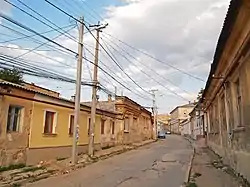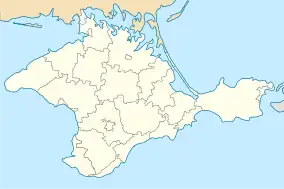Old Simferopol
Old Simferopol, known locally as the Old Town (Crimean Tatar: Eski şeer, Ukrainian: Старе місто), is an area of the city of Simferopol which until the end of the 18th century served as the centre of the city of Aqmescit. The old town consists of narrow, short streets constructed in a traditional Turkic style. In the 19th century it was also referred to by travellers as the "Asian town" because of the contrast with Simferopol's other regular, European-style neighbourhoods. Today, some of the neighbouring 19th-century, single-storey, European-style buildings are also considered to be part of the old town. The area is bounded by Lenin, Sevastopol's'ka, Krylov, and Chervonoarmiis'ka streets. The population of the old town is approximately 50,000.[1]
Old Simferopol
Eski şeer | |
|---|---|
Area of Simferopol | |
 Street in Old Simferopol | |
 Old Simferopol | |
| Coordinates: 44°56′51″N 34°06′28″E | |
| Country | |
| Administrative division | Autonomous Republic of Crimea |
| City | Simferopol |
| District | Kyivskyi |
| Population (2019) | |
| • Total | approx. 50,000 |
The Old Town is unique in Simferopol for its preserved historic architecture and layout. In the 1950s-1970s, many film studios in the Soviet Union used Old Simferopol as a set for films set in historical provincial towns.[2] Today the Old Town suffers from a number of a development problems and remains a point of contention for the Russian-controlled city administration.
History
_(29064303993).jpg.webp)
_(29398222710).jpg.webp)
The modern-day old town is located on the site of the Crimean Tatar town of Aqmescit, which later became part of Simferopol after the city was founded.[3][note 1] Kebir-Jami, the settlement's main mosque, was built in 1508 from grey-white limestone, which gave the city the name of Aqmescit (in Crimean Tatar, literally "white mosque"). By 1783 there were 308 houses in the town (of which 84 had been partially destroyed by Russian Imperial forces under the leadership of Burkhard Christoph von Münnich in 1736), seven mosques, three maktabs, and one madrassa.[5]
Most houses at that time were single-storey buildings made of clay mortar, with tiled roofs. The different blocks were curved in shape and separated from each other by narrow streets and numerous cul de sacs. In two-storey buildings, the ground floor was set aside for commercial and non-personal use. It is assumed that the street layout was designed to confuse an invading army in the event of an invasion, causing them to get lost in the maze of streets.[5]
Drinking water for the town was taken from springs on the eastern slopes of Scythian Neapolis. 18th-century Prussian traveller Peter Simon Pallas later described the town's water source as follows:
Originally, the town was served by an underground water supply, which originated in a spring located three versts from the city, near the Bakhchysarai road.[5]
Following the Annexation of the Crimean Khanate by the Russian Empire in 1783, it was decided to move the capital of Taurida Oblast (encompassing the majority of the lands of the annexed Crimean Khanate) from the city of Karasubazar[note 2] to the town of Aqmescit.[6] Simferopol proper is considered to have been founded in 1784.[7] In the minutes of a meeting of Taurida Oblast's government, it is noted that "from Aqmescit, the local capital city of Simferopol will be created." In 1784, under the leadership of Prince Grigory Potemkin, work began on administrative and residential buildings as well as an Orthodox church in the area north-west of Kebir-Jami Mosque. The border between the city blocks constructed under the Crimean Khanate and those constructed under the Russian Empire runs approximately along the modern-day Karaimskaia, Kavkazskaia, and Proletarskaia streets.
At the turn of the 20th century, the Old Town was home primarily to a Jewish, Crimean Karaite, Crimean Tatar, Roma, Greek, and Armenian population.[8]
In 1927, a cinema named after Turkish revolutionary Mustafa Subhi was opened to serve the local Crimean Tatar population.[9][note 3]
From 1941 to 1944, the city of Simferopol was occupied by Nazi Germany. This period was characterised by massacres against the civilian population, in particular the Jewish and Roma populations of the Old Town.[10]
In April 1944, the Red Army regained control of Simferopol. In May, Soviet leader Joseph Stalin ordered the deportation of the Crimean Tatars to Central Asia as collective punishment for perceived pro-Nazi collaboration. The deportation was supervised by Lavrentiy Beria and was concentrated particularly in the predominantly-Tatar area of the Old Town.
After the collapse of the Soviet Union in 1991, Old Simferopol became part of newly-independent Ukraine, and many Crimean Tatars were allowed to return to their historical homeland. The city of Simferopol, including the Old Town, became the subject of a number of land disputes between residents of houses seized from deported Tatars, and the descendants of deportees wishing to return.[11]
Following the 2014 Russian annexation of Crimea, Old Simferopol once again found itself under Russian control. International organisations continue to express concerns about collective punishment and ethnic cleansing directed against the Crimean Tatar population.[12] Today, the Old Town is inhabited primarily by the city's Russian population.[13]
Development
Old Simferopol suffers from a number of development problems, including the lack of a functioning sewage system, poor road surfacing, lack of street lighting, poor state of building repair and chaotic development.[14] Due to the close proximity of the Old Town to Simferopol's city centre, the Russian-controlled city administration has proposed the demolition and redevelopment of Old Simferopol a number of times.[8] Following the 2014 Russian annexation of Crimea, many residents of the Old Town were unable to register themselves as the owners of their own houses and flats.[15]
In 2015, Ernst Mavliutov, chief architect of the city of Simferopol, stated that the Old Town would not be redeveloped with high-rise housing.[16] In 2018, however, Chief Architect of the Republic of Crimea Irina Solovyova announced that the authorities intend to carry out renovation works in Old Simferopol, including the demolition of dilapidated housing.[17]
Gallery
 Kebir-Jami Mosque at the start of the 20th century
Kebir-Jami Mosque at the start of the 20th century Apartment building on Efremov Street
Apartment building on Efremov Street House which was once home to the Russian poet Konstantin Batyushkov
House which was once home to the Russian poet Konstantin Batyushkov![Talmud-Tora [ru] Jewish School](../I/%D0%95%D0%B2%D1%80%D0%B5%D0%B9%D1%81%D0%BA%D0%BE%D0%B5_%D0%BE%D0%B1%D1%89%D0%B5%D1%81%D1%82%D0%B2%D0%B5%D0%BD%D0%BD%D0%BE%D0%B5_%D1%83%D1%87%D0%B8%D0%BB%D0%B8%D1%89%D0%B5_%22%D0%A2%D0%BE%D0%BB%D0%BC%D1%83%D0%B4-%D0%A2%D0%BE%D1%80%D0%B0%22%252C_%D0%B2%D0%B8%D0%B4_%D1%81_%D1%83%D0%BB._%D0%A1%D1%82%D1%83%D0%B4%D0%B5%D0%BD%D1%87%D0%B5%D1%81%D0%BA%D0%B0%D1%8F.JPG.webp) Talmud-Tora Jewish School
Talmud-Tora Jewish School![Seit-Settar Cami Mosque [uk]](../I/Simferopol%252C_Seit-Settar_Jami_Mosque%252C_2016.06.18_(01)_(29398149540).jpg.webp) Seit-Settar Cami Mosque
Seit-Settar Cami Mosque Tomb of the religious elder Aziz Salgir-Baba
Tomb of the religious elder Aziz Salgir-Baba![Ner Tomid Synagogue [ru]](../I/%D0%9D%D0%B5%D1%80-%D0%A2%D0%BE%D0%BC%D0%B8%D0%B4%252C_2017_(2).jpg.webp) Ner Tomid Synagogue
Ner Tomid Synagogue![Simferopol Kenesa [uk]](../I/%D0%91%D1%83%D0%B4%D0%B8%D0%BD%D0%BE%D0%BA_%D0%BA%D0%BE%D0%BB%D0%B8%D1%88%D0%BD%D1%8C%D0%BE%D1%97_%D0%BA%D0%B5%D0%BD%D0%B0%D1%81%D0%B8_2.jpg.webp) Simferopol Kenesa[note 4]
Simferopol Kenesa[note 4]
Notes
- The city of Simferopol continues to be known as Aqmescit in the Crimean Tatar language.[4]
- Since renamed in 1944 to Bilohirsk.
- Following the deportation of the Crimean Tatars in 1944, the cinema was renamed "Rodina", Russian for "homeland".
- A kenesa is an Eastern European or Persian Karaite synagogue.
References
- Смутко, Алина. "Новая осень в старом городе". Крым.Реалии (in Russian). Retrieved 21 March 2023.
- "Фильмы, которые снимались в Симферополе". 365 дней в Крыму с Викой Марченко (in Russian). 29 June 2020. Archived from the original on 2020-06-29. Retrieved 24 March 2023.
- "9 малоизвестных фактов о Симферополе". crimea.kp.ru (in Russian). 7 June 2015. Retrieved 23 March 2023.
- "Aqmescit taqiqat tevqifhanesinde Hersondan hırsızlanğan daa bir ukrainni taptılar - QUG". crimea.suspilne.media (in Crimean Tatar).
- Кутайсова, Марина (2018). Симферопольская старина в фотографиях и описаниях (in Russian). Альбатрос. pp. 15–41.
- "Симферополь". Энциклопедический словарь Брокгауза и Ефрона (в 86 т. (82 т. и 4 доп.)) (in Russian). 1890–1907. Retrieved 23 March 2023.
- Vvedensky, Boris (ed.). "Симферополь". Большая Советская Энциклопедия (in Russian) (2-е изд. том 39 ed.). Москва: Государственное научное издательство «Большая Советская энциклопедия». pp. 74–75.
- Дремова, Наталья; Ткачев, Александр (25 January 2019). "Ак-Мечеть: улыбка прошлого. Старый город планируют снести?". Аргументы и факты (in Russian). Archived from the original on 2019-01-25. Retrieved 23 March 2023.
- Свод памятников истории, архитектуры и культуры крымских татар (Том III) (in Russian). Белгород: КОНСТАНТА. pp. 305–308, 392.
- Klee, Ernst (2005). Das Personenlexikon zum Dritten Reich (in German) (2 ed.). Frankfurt am Main: Fischer Taschenbuch Verlag. p. 72.
- "Tatars push to regain their historic lands in Crimea". Today's Zaman. 30 September 2007. Archived from the original on 2007-09-30. Retrieved 23 March 2023.
- Jordash, Wayne; Mykytenko, Anna (25 February 2021). "Russia's collective punishment of the Crimean Tatars is a war crime". Atlantic Council. Retrieved 23 March 2023.
- "Севастополь в цифрах переписи". sevastopol.press (in Russian). Retrieved 24 March 2023.
- "Дороги в Старом городе Симферополя ужасают". avdet.org (in Russian). 10 July 2018. Retrieved 24 March 2023.
- "Почему симферопольцы не могут оформить "квартиры на земле"". Российская газета (in Russian). 30 October 2019. Retrieved 24 March 2023.
- "Архитектор Симферополя рассказал, как будут сносить Старый город". Агентство Крымские Новости (in Russian). 29 June 2020. Archived from the original on 2020-06-29. Retrieved 24 March 2023.
- "Главный архитектор Крыма пообещала Старому городу Симферополя реновацию". Крымская Газета (in Russian). 21 February 2019. Archived from the original on 2019-02-21. Retrieved 24 March 2023.